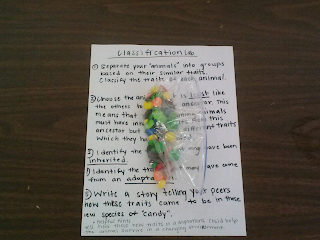Lesson Plan for the Mega-Lab:
-->
Lesson
Observation #4
Animal
Classification Mega-Lab
Student
Teacher Ms.Tiffany Hedrick
Subject: Life Science
Main Standard:
S5L1. Students will classify
organisms into groups and relate how they determined the groups with how and
why scientists use classification.
a. Demonstrate how animals are sorted into groups
(vertebrate and invertebrate) and how vertebrates are sorted into groups (fish,
amphibian, reptile, bird, and mammal).
b. Demonstrate how plants are sorted
into groups.
Additional Standards:
Literacy Integration
CCGPS Reading, Writing, Listening and
Speaking Standards
SL. 3. 1 Engage effectively in a range of collaborative
discussions (one-on-one, in groups, and teacher-led) with diverse partners on
grade 3 topics and texts building on others’ ideas and expressing
their own clearly
SL. 3. 6 Speak in complete sentences when appropriate to task and
situation in order to provide requested detail or clarification
L. 3. 3 Use knowledge of language and its conventions when
writing, speaking, reading or listening
|
Understandings:
Students will understand that…..
-living things are grouped based on
similarities and differences
-vertebrates animals are sorted into
groups –
-scientists use classification to -identify and study new species
Essential Questions:
-Why do scientists
classify living things?
-How do scientists
group organisms?
Objective:
Students will understand that living
things are grouped based on similarities and differences vertebrates animals
are sorted into groups scientists use classification to identify and study new
species.
Technology Integration:
-Projector
-Online
Timer
-Flip
Chart (Computer)
-ActivExpressions-
Experiment in Auditorium
Materials:
-7
classification posters
-Reflection
sheet for each student (75)
-pencils
for each student
-Dry
Erase Markers (at least 6 per center)
-Variety
of Candy (2-3 large bags)
-Pipe
Cleaners (one large bag)
-Macaroni
noodles (10 small bags)
-Construction
paper (75 sheets)
-Scissors
(12)
Instruction:
Opening
& Review (5-10min):
-Explore
Review FlipChart with students.
-Ask
review questions. Students will respond
with ActivExpressions.
-Introduce
the centers.
Work
Period (45min):
Labs/Centers:
15 min per center
Center
#1: Students will review the differences
between vertebrate and invertebrate.
Students will create backbones using art materials. Students will explore how the backbone can
still move flexibly but still maintains a hard shape.
Center
#2: Students will review how to classify
and sort living things. Students will
practice sorting and classification by arranging various candy into smaller
groups based on traits.
Center
#3: Students will review vocabulary
associated with the classification of living things. Students will review the
vocabulary as they complete a large, poster-sized word sort.
Review
(5min):
-Students
will reflect on their lab experience with lab worksheets.
-When
students return to class, the teacher will review their findings as a group.
Assessment:
Each
student will be assessed by their participation and completed lab reflection
sheets. The teachers will watch all
students and will collaborate and discuss their observations of students after
the lab is complete. The teachers will
note if there were any students who struggled with the ActivExpressions or with
any of the center activities.
Posters for the Activity:
Posters for the Activity:
PICTURES FROM THE MEGA-LAB!!!!
Myself: Closing the Flip Chart presentation and transitioning to centers.
Here I am explaining the directions for our vertebrate and invertebrate lab/center.
Handing out our materials to the students.
Ms. Thomas and her student teacher explaining their candy sorting lab that connects classification.
Mrs.Mitchell-Reed and her student teacher, Ms.Lemon, reviewing vocabulary words and providing directions for the word search activity.
I would not have been able to
accomplish such a successful Mega-Lab without the help of my fellow Student Teachers
and Certified Teachers. This lab was proof that successful collaboration is key
to a successful and thriving learning environment. This large lab was a megahit because all of
the students were thoroughly engaged at each station and they were extremely
excited about learning! All seventy-five
students were able to complete their lab sheets successfully and were able to
clearly explain the standards and new knowledge gained from their experience. This was the most challenging, thrilling,
engaging, blockbuster lesson that I have ever created. I intend on implementing many more Mega-Labs
in my future!














No comments:
Post a Comment